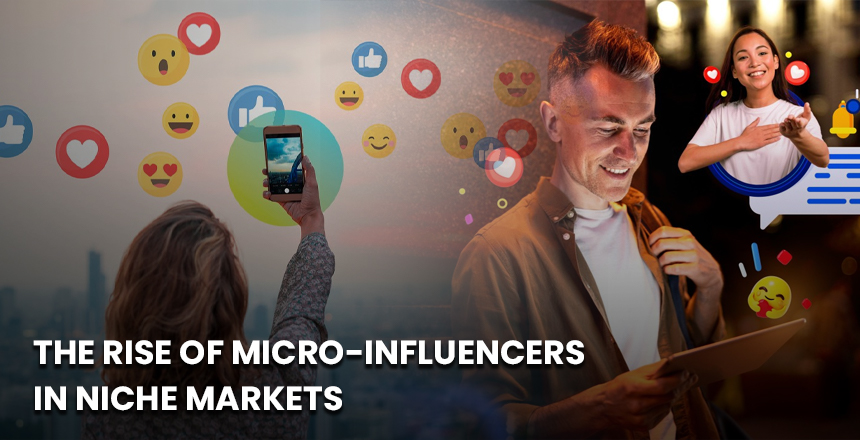In recent years, the landscape of influencer marketing has undergone a significant
transformation. Where mega-influencers and celebrities once dominated the scene, a new
category has emerged as a powerful force: micro-influencers. With their smaller yet highly
engaged audiences, micro-influencers are reshaping how brands connect with consumers,
especially in niche markets.
Who Are Micro-Influencers?
Micro-influencers are individuals with social media followings ranging from 1,000 to 100,000.
Unlike macro or celebrity influencers, micro-influencers are often everyday people who focus on
specific niches, such as fitness, food, travel, fashion, or technology. Their expertise and genuine
passion for their subjects make them relatable and trustworthy to their followers.
Why Are Micro-Influencers Thriving in Niche Markets?
The rise of micro-influencers can be attributed to several factors:
- Authenticity and Trust
Audiences today crave authenticity. Micro-influencers are seen as real people who genuinely
believe in the products they promote. Their smaller, more engaged communities trust their
recommendations because they feel personal and less like traditional advertisements. - Cost-Effectiveness for Brands
Working with micro-influencers is often more budget-friendly than partnering with larger
influencers or celebrities. Brands can collaborate with several micro-influencers for the same
cost as a single macro-influencer, allowing them to reach diverse audiences within niche
markets. - Higher Engagement Rates
Studies consistently show that micro-influencers have higher engagement rates compared to
their macro counterparts. Their followers interact more actively with their content, creating
meaningful conversations around products and services. - Targeted Audience Reach
Micro-influencers excel in niche markets because they cater to specific interests. Whether it’s
vegan cooking, sustainable fashion, or gaming, they attract followers who are genuinely
interested in those areas, making it easier for brands to target the right audience.
The Power of Micro-Influencers in Niche Markets
- Building Community
Micro-influencers are community builders. They foster a sense of belonging among their
followers by sharing relatable content and engaging directly with them. For niche markets, this
sense of community is invaluable, as it creates a loyal customer base. - Driving Word-of-Mouth Marketing
Because micro-influencers are seen as peers rather than celebrities, their recommendations
often feel like word-of-mouth suggestions. This personal touch can significantly impact
consumer behavior, especially in niche markets where trust is a key factor. - Promoting Specialized Products and Services
Niche markets often have products or services that require in-depth understanding and
communication. Micro-influencers, with their expertise and dedication, can effectively promote
such offerings by highlighting their unique features and benefits.
Challenges in Collaborating with Micro-Influencers
While micro-influencers offer numerous advantages, working with them is not without
challenges:
Scalability
Since micro-influencers have smaller audiences, brands often need to work with multiple
influencers to achieve their desired reach, which can be time-consuming.
Finding the Right Fit
Identifying micro-influencers who align with a brand’s values and target audience requires
careful research and vetting.
Maintaining Consistency
Collaborating with numerous micro-influencers can sometimes lead to inconsistent messaging,
which can dilute the brand’s impact.
Strategies for Brands to Leverage Micro-Influencers
To make the most of micro-influencer partnerships, brands should consider the following
strategies
- Define Clear Objectives
Before reaching out to micro-influencers, brands should establish clear goals for their
campaigns, such as increasing brand awareness, driving sales, or promoting a new product. - Prioritize Authenticity
Brands should allow micro-influencers to create content in their unique voice rather than
imposing strict guidelines. This approach ensures the messaging feels organic and resonates
with the audience. - Leverage User-Generated Content
Micro-influencers often produce high-quality, relatable content that brands can repurpose for
their marketing channels, adding value to the collaboration. - Use Data to Measure Success
Brands should track key metrics, such as engagement rates, website traffic, and sales
conversions, to assess the effectiveness of their campaigns with micro-influencers.
Success Stories of Micro-Influencers in Niche Markets
Several brands have successfully harnessed the power of micro-influencers in niche markets:
Glossier, a beauty brand, leveraged micro-influencers to build a cult following by focusing on
authentic reviews and user-generated content.
Gymshark, a fitness apparel company, collaborated with fitness micro-influencers to establish
itself as a leading brand in the fitness community.
Daniel Wellington, a watch brand, used micro-influencers to create buzz and increase sales
through Instagram, reaching audiences in fashion and lifestyle niches.
The Future of Micro-Influencers
As social media platforms continue to evolve, the role of micro-influencers in niche markets is
expected to grow. Trends such as the rise of short-form video content, AI-driven influencer
marketing platforms, and an increasing emphasis on authenticity will further cement their
importance.
Moreover, as consumers become more selective about the content they engage with, brands
that embrace micro-influencers will have a competitive edge in building meaningful connections
with their audiences.
Conclusion
The rise of micro-influencers in niche markets signifies a shift towards more personalized,
authentic, and targeted marketing strategies. By tapping into the power of micro-influencers,
brands can build trust, foster community, and drive significant results. As this trend continues to
gain momentum, those who adapt and invest in micro-influencer collaborations will undoubtedly
reap the rewards in the years to come.
:








